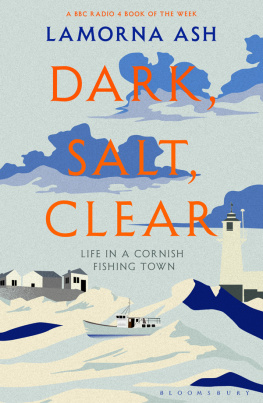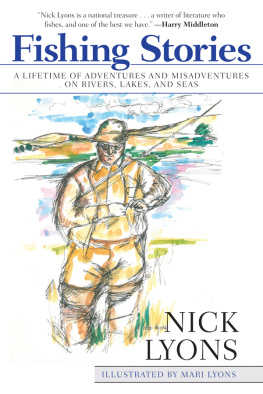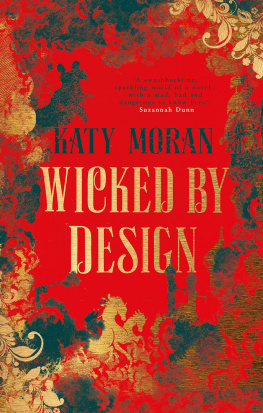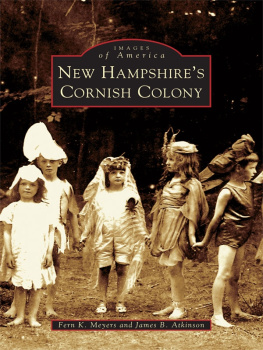
DARK, SALT, CLEAR
BLOOMSBURY PUBLISHING
Bloomsbury Publishing Plc
50 Bedford Square, London, WC1B 3DP, UK
BLOOMSBURY, BLOOMSBURY PUBLISHING and the Diana logo are trademarks of Bloomsbury Publishing Plc
First published in Great Britain 2020
This edition published 2020
Copyright Lamorna Ash, 2020
Lamorna Ash has asserted her right under the Copyright, Designs and Patents Act, 1988, to be identified as Author of this work
Text from A Year of Magical Thinking by Joan Didion reprinted by permission of HarperCollins Publishers Ltd 2005, Joan Didion
Text from The Collected Stories of Dylan Thomas by Dylan Thomas 1954, Dylan Thomas. Reprinted by permission of New Directions Publishing Corp.
Text from New Collected Poems of Marianne Moore by Marianne Moore, reprinted with permission of Faber and Faber Ltd.
Text from Elizabeth Bishop: Prose The Centenary Edition by Elizabeth Bishop published by Chatto and Windus, reprinted with permission of The Random House Group 2011, Elizabeth Bishop
Text from The Complete Poems by Elizabeth Bishop published by Chatto and Windus, reprinted with permission of The Random House Group 2004, Elizabeth Bishop
Text from Arctic Dreams by Barry Lopez, published by Vintage and reprinted by permission of the Random House Group Ltd 2014, Barry Lopez
All rights reserved. No part of this publication may be reproduced or transmitted in any form or by any means, electronic or mechanical, including photocopying, recording, or any information storage or retrieval system, without prior permission in writing from the publishers
A catalogue record for this book is available from the British Library
ISBN: HB: 978-1-5266-0001-1; eBook: 978-1-5266-0002-8
To find out more about our authors and books visit www.bloomsbury.com and sign up for our newsletters
To Denise and Lofty,
Don and Isaac
CONTENTS
The life class model in Newlyn was nothing like the ones Id come across back home in London. His body bore the marks of a life lived hard his arms strong and sinewy, his face cross-hatched by wrinkles, his back and biceps scribbled all over with dark blue tattoos. I wanted to believe he had once been a fisherman, but he did not speak to us so I never found out. As we sipped tea there, in the bare studio room of Newlyn Art School up the top of Old Paul Hill, he stood in silence facing the large wooden windows, from where he could have seen the whole of Mounts Bay yawning out in both directions, if only the black night sky had not covered the view.
When he posed for us, he did not curve his body self-consciously across some chaise longue but looked at us head on, legs apart, arms outstretched as if to say: Here I am ! Observing me as I sketched the mans outline messily, hungrily, at breakneck speed, rubbing out lines, starting again, failing once more to capture his shape the art teacher came over and asked me to put down my pencil. When drawing a body, she explained, do not look at the limbs themselves, the shapes and positions you expect the human form to assume, but instead at the negative space around them the triangles inside the crook of each arm, the crescent that emerges on the other side of where the waist slopes inwards. By following this method the figure will materialise on the paper of its own accord, not how you imagine it ought to appear, but how it really is: the flesh-and-blood person standing before the row of canvases.
I took a breath and relaxed. This was new; there was another way of looking at things.
It was not until I started drawing that I recognised the way I attempt to take the world in. When I sketch, I want the whole image to appear at once; I push the pencil hard against the paper until it is all but blunt, desperately trying to commit whatever is before me to the page. It is the way I speak, too, bloating each sentence out with as many exhaustive pieces of information as I can to ensure my poor audience does not miss a single moment of what I am trying to conjure.
That bare-boned man, built of so many negative spaces and unresolved marks and shadings, contained in his being all that I was yet to understand about Newlyn. What I had failed to see is that a place is alive; it too is flesh and blood standing before you, arms outstretched, mouth open, ready to call out: Here I am ! if only you would pause for a moment to listen.
John Steinbeck articulates the life of places better than any other writer I know, especially in his novella Cannery Row . I first read it on the advice of a good friend from Lelant, a village on the north Cornwall coast where the female line of my family has lived for generations. Since returning to London, it is this book that has found itself most frequently in my backpack as I commute, batted like a mouse in a cats paws from one end of the city to the other to tutor children. I show each child the prologue to Cannery Row on our first English session together. I show it to them because I want them to know that there are writers who arent afraid of admitting the near impossibility of transforming landscapes and people into writing, but who try anyway. I show it to them to remind myself of that same truth as I work on my own writing.
Cannery Row in Monterey in California, Steinbeck tells us, is a poem, a stink, a grating noise, a quality of light, a tone, a habit, a nostalgia, a dream In one breath, he gives us the heavy, industrial percussion of a working fishing village which teems with life, and stinks and grates.
That doesnt mean anything ! How can a place be a stink ? interrupts one ten-year-old tutee.
It couldnt be, I tell her, if that were all Steinbeck had written of Cannery Row. Each of these sensations is necessary to the others the way the light hits the warehouse buildings at different hours, the way the sounds intensify at dawn and fade away at dusk each day in time with the work beginning and ending, the potent stench of fish as it arrives into the factories off the boats, how it feels to stand right in the middle of a place where all these sights and sounds and smells occur together. What it means is that a place is every sense pricked, every sense activated at once.
Next, Steinbeck tells us of the strange, hushed magic left behind each evening, which is nostalgic, which is but a dream once more come the next morning. In this brief description of the workers who daily descend on Cannery Row he teaches us how places are nourished by those who gather in them, whose own multiple, contradictory parts render them just as complex and cosmic as the places themselves.
How, the books narrator finally asks, can the poem and the stink and the grating noise the quality of light, the tone, the habit and the dream be set down alive? He answers his own question immediately through a scientific analogy a nod to Steinbecks closest friend in California, Ed Ricketts, a marine biologist and the inspiration for Doc, the principal character in Cannery Row . Since a marine flat worm breaks and falls apart when you try to catch it whole, you must instead let them ooze and crawl of their own will onto a knife blade and then lift them gently into your bottle of sea water. So too, in the telling of place, he advises, can you only open the page and hope the stories crawl in by themselves. After reading Cannery Row , I am mindful to greet each part of Newlyn as it finds me, letting it rush into me as the waves do against the ragged Cornish cliffs that stand before the Atlantic like custodians of the land, marking them, softening them, reshaping their boundaries with each rising swell.
Next page











